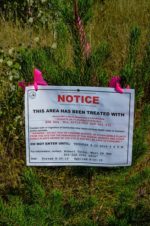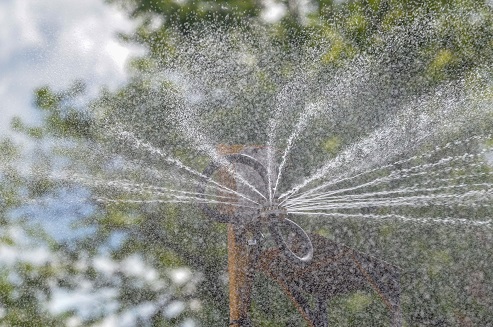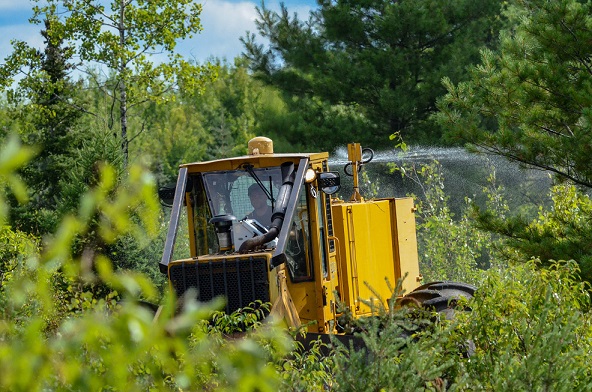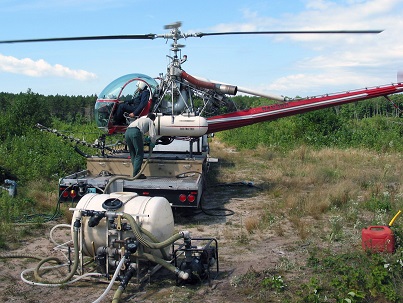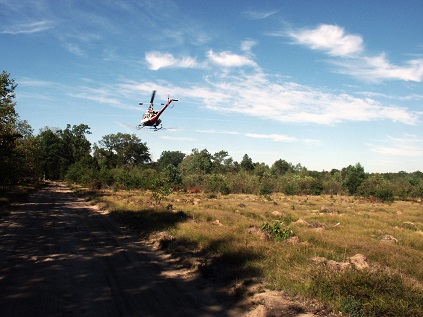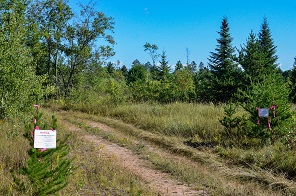By KATHLEEN LAVEY Michigan Department of Natural Resources
From now through fall, people who visit or live near state forests may find signs posted that say herbicide spraying has taken place. They may occasionally find a road closed to off-road vehicle traffic or even see a helicopter flying above, trailing a mist of herbicide.
“Herbicide is an important tool for forest management, especially when preparing to plant red pine,” said Scott Throop, timber management specialist with the Michigan Department of Natural Resources. The DNR’s Forest Resources Division manages more than 4 million acres of state forest land with practices that are certified as sustainable by third-party organizations.
Herbicides can be used to prepare for planting new trees or to remove invasive species.
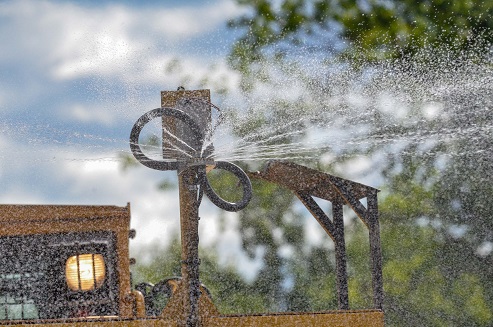
A herbicide application project is photographed from the Gwinn Forest Management in south Marquette County, in August 2019. The application was taking place to prepare the landscape for jack and red pine planting. 

“Safety is my number one concern after the decision is made to spray a site,” Throop said. “We spend a lot of time trying to mitigate the risk. We know that people use all of our state forest land, and we want to do our best to protect them.”
Keeping people safe starts with information to help them understand the process and the precautions being taken, said Jeff Stampfly, acting Forest Resources Division chief.
“We want to be open and informative with people about the various treatments we are using to manage the forests,” he said.
Parcels scheduled to be sprayed this year range from a 5-acre plot in Roscommon County to a parcel of about 1,000 acres of timber land in Kalkaska County. Roughly 9,000 acres of land in about 20 counties were scheduled for herbicide treatment this year; those plans normally are made two years in advance and are available for the public to review at .

A skidder sprays herbicide in a Michigan Department of Natural Resources forest treatment. 
Herbicide is loaded into a helicopter for spraying. 
A helicopter sprays herbicide during a Michigan Department of Natural Resources treatment.
To put that in perspective, if the DNR sprays all 9,000 acres, that represents only two-tenths of one percent of Michigan’s state forest land base. It is likely that workers will be able to spray only about half of that acreage this spraying season. But even though the area is small in terms of acreage, it represents a huge investment that will ensure quality timber into the 22nd century.
This year, spraying began in June at research sites in conjunction with Michigan State University researchers, who are studying hardwood regeneration. Removing competition from other plants with herbicide helps researchers evaluate various tree-growing methods equally.
The spraying season, from July through September, usually takes place to prepare the ground for planting red pine the following spring or, in a few cases in the Upper Peninsula, jack pine trees. Spraying later in the fall kills hardwood saplings and grass
while leaving the pines unharmed as they have gone dormant for the winter.
Several different herbicide products are used, depending on the site and the desired result. In every case, Throop said the goal is to use the lightest concentration of the herbicide product possible.
“Our chemical mixes are designed to work at the low end of the concentration range,” Throop said. “We’re typically far from the high end of permitted use.”
All DNR herbicide applicators are licensed and trained in the safe use of these products, and all herbicides used by the DNR are approved by the U.S. Environmental Protection Agency.
When an area is to be sprayed, signs are posted beforehand at every access point to the property, including roads and trail heads. The signs specify what is being done and give a contact number people can call if they want to talk to DNR staff about the spraying.
Nearby landowners also are notified, although sometimes it is difficult to reach owners of seasonal homes. DNR staff and contractors are careful to try to accommodate neighbors’ concerns.
“We sprayed an area in Kalkaska County where there were lots of neighbors,” Throop said. “In order to mitigate potential conflicts, we moved spraying to the middle of the week to lessen impacts in the area.”
Herbicide is usually applied from a large piece of all-terrain equipment known as a skidder or sometimes, a helicopter is used.
“One of our major concerns when spraying from a helicopter is drift,” Throop said. “If winds are such that drift becomes unacceptable, we’ll stop aerial spraying for that day.”
After an area is sprayed, signs are left in place for at least 48 hours and sometimes longer. Out of an abundance of caution, people are advised not to pick berries from sites that have been sprayed recently.
Herbicide spraying becomes obvious in subsequent days as plants begin to turn brown.
“People notice something was done, and they can call us at any time with questions,” Throop said.
To learn more about how and why the DNR manages almost 4 million acres of state forest, visit


